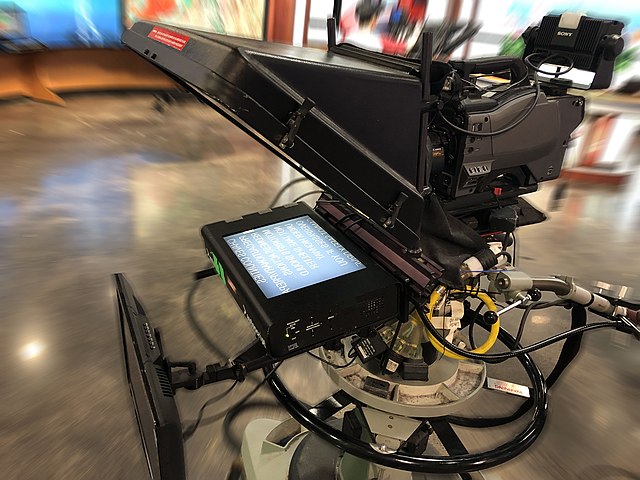For many years, the typewriter was my main tool. When I first went on the air, there was no such thing as a prompter so we had to read the copy, held in our hand, while looking at the camera as much as we could. A prompter, brand name Teleprompter but it has probably become generic now, is a piece of treated glass that sits at 45 degrees in front of the camera lens. There is a computer screen 45 degrees from it and 90 degrees from the lens. The system I have now uses an iPad.


I think Walter Cronkite’s people were the first to use an early model, which instead of a computer screen…which hadn’t been invented yet…was a box with reverse image copy in it and a light shining on the copy. The reverse image copy was reflected up on the 45 degree glass and Walter, and the rest of us who used this system, were able to read it while looking directly at the camera lens. The reverse image copy looked normal to the anchor, when reflected on the glass.
A person would stand alongside the box and pull the page out when the anchor finished reading it. The system also allowed us to rearrange or add new stories on the fly. But here’s the fun part. In order to get the reverse image copy for the prompter, we had to insert a piece of carbon paper backwards into the typewriter carriage. (The carriage is the part at the top with the roller, that holds the paper.) Also in this group of pages, was the first page that the anchor held in his hand while on the air, a second page followed by the carbon paper reversed for the prompter, then another piece of carbon paper facing the correct way and another piece of paper which went to the director so he could follow along and know when to flash up a slide or roll a projector with a film story. I think I have this right. I don’t know if they make carbon paper anymore so I can’t check it. I still have my bulletin size typewriter, but the ribbon has probably dried out. Eventually someone invented a carbon pack which held all the papers and carbon paper and a tear off at the top so the pages could be separated for the different uses. But at the start we had to build the pack every time we put paper in the typewriter.
Later came the conveyor belt. The copy was taped together, page by page, the bottom of the first page to the top of the second, and so on. Somewhere along this parade of pages, a small camera picked up the image, reversed it, and sent it to a monitor under the studio camera lens to reflect up onto the 45 degree glass in front of the lens. It was a fine system until you had to update a story or rearrange the order. Then the operator would have to untape and retape. There also was the problem of the belt getting out of alignment and the parade of pages started missing the little camera. Being a new anchor had it’s drawbacks at times.
As I said, the computer changed all this. Now a reporter can sit at her newsroom desk, type her story and send it to the prompter, the anchor, the director, the producer, and anyone else who needs it. I really don’t miss the old days, like I do not miss film, and I do not miss tape. But that is a blog for another time. -dm